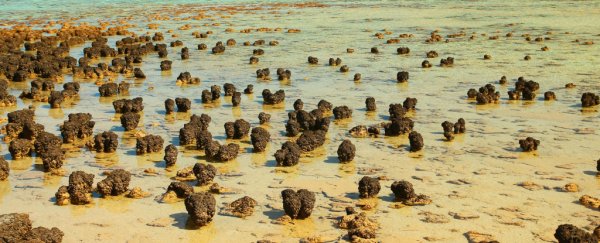Complex life might have come and gone on Earth long before the multicellular organisms we're familiar with today arose, a new study suggests.
It's generally thought that the evolution of complex life was a rare, once-in-4.5-billion-years event. But new research suggests that conditions were right for complex cells to evolve and die off at least once - or perhaps several times - before our lineage even got started.
What does that mean? Billions of years ago, there could have been other complex life forms on the planet, totally unrelated to anything we see on Earth today.
But let's backtrack for a second. Earth has been around for an estimated 4.5 billion years. Around 3.7 billion years ago, while the planet was still relatively fresh, two of the three kingdoms of life we see on Earth today - bacteria and archaea - arose.
It's thought that these simple, single-celled organisms survived for billions of years on their own, until around 1.75 billion years ago, when the third kingdom of life, eukaryotes, appeared.
The eukaryote family tree encompasses all complex organisms on the planet, including animals (that's us), plants, fungi, and protists.
It's still debated exactly how eukaryotes arose, but the most accepted hypothesis is that an archea swallowed a bacterial cell, and the two developed a symbiotic relationships that allowed them to work together to become more complex.
Eventually, the bacteria became the mitochondria we see in our cells today.
Whether that scenario is true or not, researchers think the event could only happen thanks to its timing - the reason we didn't see eukaryotes before that is because there simply wasn't enough oxygen in our atmosphere as yet.
Oxygen began building up billions of years ago thanks to cyanobacteria, but it took a long time - until approximately 1.6 billion years ago - to get up to levels that were suitable for complex life. Or, at least, that what we've always thought.
Now, a new study by the University of Washington has found evidence that there was enough oxygen in Earth's atmosphere between 2.4 and 2 billion years ago before it dropped off again suddenly.
This suggests that the ingredients for complex life were present before the first fossil evidence of eukaryotes.
"There is fossil evidence of complex cells that go back maybe 1.75 billion years," said astrobiologist Roger Buick. "But the oldest fossil is not necessarily the oldest one that ever lived - because the chances of getting preserved as a fossil are pretty low."
"This research shows that there was enough oxygen in the environment to have allowed complex cells to have evolved, and to have become ecologically important, before there was fossil evidence," he added. "That doesn't mean that they did - but they could have."
That last point is pretty important - we need to make it clear that no one has found fossil or DNA evidence of this earlier complex life.
What the team is saying is that the ingredients were there for it to have evolved hundreds of millions of years before the first eukaryote, but we're still not sure if that actually that happened.
So why wouldn't this hypothetical life have survived until today if it did evolve? The research showed that although there was an early 'bubble' of oxygen in the atmosphere, it crashed shortly afterwards, which would most likely have killed the lifeforms off.
To figure this out, the team analysed traces of the chemical element selenium trapped in pieces of sedimentary shale dating back between 2.4 and 2 billion years ago.
They were looking to see if the selenium had been changed by the presence of oxygen, or oxidised - a reaction that leaves a signature in the ratio of selenium isotopes stored in the rocks.
Traditionally, it was assumed that oxygen on Earth had a history of "none, then some, then a lot", said Buick.
"But what it looks like now is, there was a period of a quarter of a billion years or so where oxygen came quite high, and then sunk back down again."
It wouldn't have been enough time for complex life to diversify and take hold on the planet, but it's possible that some complex organisms could have arisen before dying off again when the oxygen crashed.
In the past, researchers had predicted that this early oxygen increase - known as the 'oxygen overshoot' - might have occurred, but this is the first time it has been studied in detail.
The same technique could also one day be used to measure the historic oxygen levels on Earth-like planets outside our Solar System, as a way of assessing whether they might have ever hosted life.
So what caused Earth's oxygen levels to soar early on, only to crash again?
"That's the million-dollar question," said one of the researchers, Eva Stüeken, from St Andrews University in Scotland. "It's unknown why it happened, and why it ended."
"It is an unprecedented time in Earth's history," added Buick. "If you look at the selenium isotope record through time, it's a unique interval. If you look before and after, everything's different."
We might never know for sure whether complex life originated and died out before the first eukaryotes, but it's interesting to note that the conditions that paved the way for complex life on Earth might not be quite as rare or unique as we previously thought.
The research has been published in Proceedings of the National Academy of Sciences.
